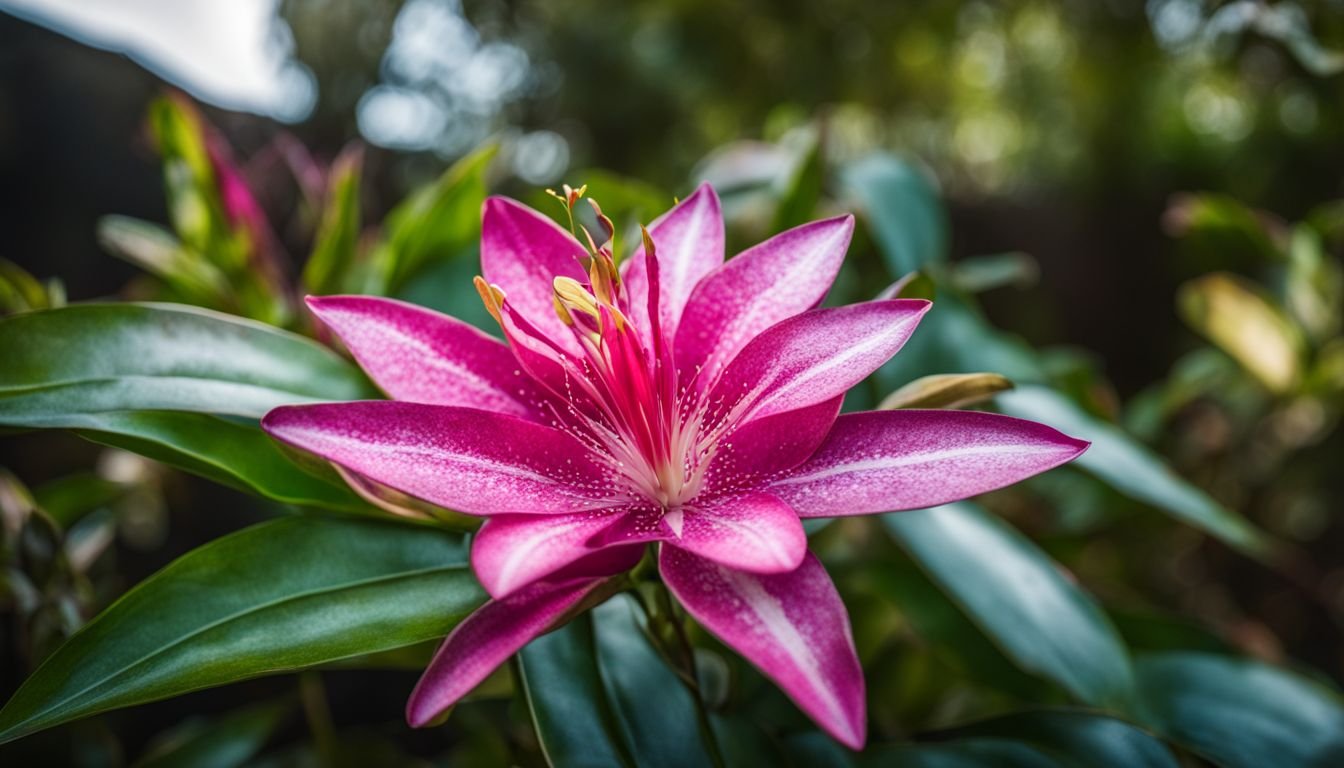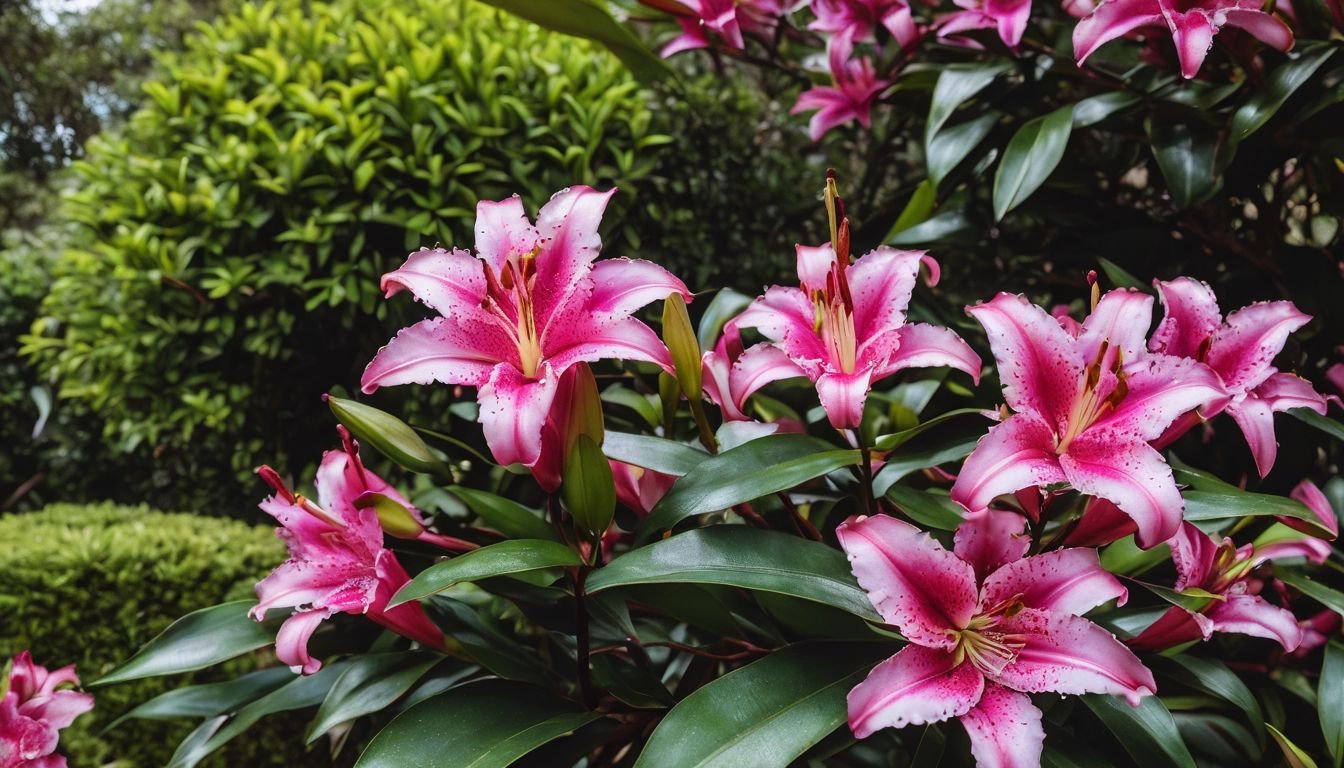Struggling to get your Lilly Pilly bushes lush and full? You’re not alone. Many gardening enthusiasts face the challenge of nurturing these native Australian beauties to their full potential.
This guide promises to unpack the secrets to growing and shaping your Lilly Pilly into a garden showpiece with hands-on, practical advice. Dive in for green-thumbed success!
Key Takeaways
- Lilly Pilly is a versatile Australian native plant that thrives across various climates and can be grown as hedges or ornamental trees.
- The right planting conditions, including fertile soil, proper sunlight, good drainage and regular fertilisation, are essential for the healthy growth of Lilly Pillies.
- Pruning is crucial to maintain shape, promote dense growth and prevent common diseases; timing it after the flowering season encourages better health and flowering next year.
- Disease prevention involves selecting resistant varieties, appropriate watering practices, monitoring plants regularly and using treatments like white oil sprays when necessary.
- The fruits of the Lilly Pilly are edible and can be used in jams, jellies or as additions to savoury dishes. They also attract birds to your garden.
Understanding Lilly Pilly: An Australian Native Plant

Delving deeper into the world of horticulture, let’s explore the Lilly Pilly, a gem within Australia’s diverse flora. Belonging to the myrtaceae family, this versatile evergreen tree thrives across various climates from cool temperate zones to subtropical regions.
Known for its glossy green leaves and bushy form, it makes both an excellent hedger and a standout feature in any garden design.
Lilly Pilly varieties such as Syzygium smithii (formerly Acmena smithii) have graced Australian landscapes for centuries. Gardeners cherish these plants not only for their vibrant foliage but also for their showy flowers that attract birds and insects alike.
The fruit they bear is more than just ornamental; varieties like Syzygium australe produce berries that are a delight in jams and desserts. Their adaptability means they’re drought tolerant once established, making them a smart choice for eco-conscious gardeners looking to add resilience alongside beauty to their outdoor spaces.
With regular care including mulching and pruning, lilly pillies can become strong foundational elements in any plant lover’s sanctuary.
How to Grow Lilly Pilly

Growing a Lilly Pilly isn’t just about planting a seed; it’s about understanding the conditions that allow this vibrant Australian native to thrive. Whether you’re aiming for an ornamental feature or a robust hedge, selecting the right variety is crucial to meet your landscaping desires.
Ideal conditions for growth
Lilly Pilly trees flourish in fertile, moist soil; though adaptable, they boast robust growth under ideal conditions. Ensure you plant them where they can bask in full sun or relish the coolness of semi-shade.
These hardy plants will surprise you with their drought tolerance and frost resistance. They’re equally at home in sandy soils or facing salty sea breezes along coastal stretches.
Success with Lilly Pilly hinges on good drainage and a generous layer of organic mulch to keep roots happy and hydrated. Container planting is an option for these versatile shrubs; just remember that potted Lilly Pillys need your attention with regular watering to thrive.
Whether it’s creating dense hedges or shaping into elegant topiaries, giving your Lilly Pilly the right start means lush foliage and vibrant berries ahead.
Selection of Lilly Pilly variety for specific needs
Choosing the right Lilly Pilly variety is crucial for achieving your gardening goals. If you’re planning to create a lush, dense hedge, Waterhousea floribunda or ‘Weeping Lilly Pilly’ might be your best bet; its thick glossy foliage and rapid growth are perfect for privacy screens.
For those in areas prone to pests like Psyllid and Scale, varieties resistant to these bugs will save you time and effort on maintenance.
Consider the plant’s purpose before making a decision. Ornamental gardens benefit greatly from Syzygium smithii (formerly known as Eugenia smithii), with its vibrant orange berries that attract birds and add colour to your garden space.
Smaller shrubby types can fit into tight spaces or serve as low borders while larger species make impressive standalone features. The versatility of this native Australian plant means there is a type suited for almost any need – it’s just a matter of finding the one that matches your lifestyle and local soil conditions.
Pruning Lilly Pilly for Optimal Growth
To ensure your Lilly Pilly thrives, strategic pruning is crucial. This not only shapes the plant for aesthetic appeal but also promotes vigorous growth and dense foliage, paving the way for a flourishing hedge or feature in your garden.
When to prune
Timing is crucial when it comes to pruning your Lilly Pilly. Aim for a session after the plant’s flowering season has come to an end. This strategic timing allows the plant to recover and encourages a more robust flower display in the year ahead.
Regular pruning not just enhances the aesthetic appeal but also contributes to a denser and more structured growth, especially if you’re aiming for that immaculate topiary look in your garden.
Use sharp tools and make clean cuts to keep your plants healthy while shaping them up or thinning out dense areas. With consistent attention, you’ll ensure that your lilly-pilly remains vibrant and well-groomed throughout the seasons.
Now, let’s move on to exploring proper techniques for pruning this versatile shrub effectively.
How to prune properly
Pruning Lilly Pilly goes beyond simply knowing the best season; it’s about understanding the correct techniques. A well-pruned Lilly Pilly not only thrives but also maintains an attractive shape and healthy foliage.
- Select the right tools before you begin. Use sharp secateurs for smaller branches and loppers or a pruning saw for larger limbs. Dull blades can damage the plant and invite disease.
- Start with dead or damaged branches. Carefully cut these away to prevent decay from spreading to healthy parts of the tree.
- Look for any branches that cross over others, as they can cause wounds that invite pests like aphids and whiteflies. Trim these crossover branches to improve air circulation.
- Maintain a clear trunk by removing any shoots or suckers at the base of your Lilly Pilly. This encourages growth higher up in the canopy.
- Create your desired shape by cutting back overgrown sections. For hedges, ensure the top is narrower than the base so sunlight reaches all leaves.
- Thinning out dense areas helps light penetrate through the canopy, essential for a bushy and vigorous hedge.
- Focus on promoting new growth by pruning just above leaf nodes at a 45 – degree angle. This encourages branching out where you’ve made cuts.
- Feed your Lilly Pilly after pruning to replenish nutrients lost during the process. A balanced fertiliser promotes recovery and lush growth.
- Lastly, mulch around the base to retain moisture and add organic matter back into the soil, benefitting roots and overall plant health.
Tips to Thicken Up a Lilly Pilly Hedge
Creating a lush and dense Lilly Pilly hedge adds privacy and beauty to any garden. To achieve the desired thickness, it’s crucial to implement some key gardening strategies.
- Select the right variety: Different Lilly Pilly types have varying growth patterns. Choose varieties known for their denser foliage if your goal is to create a thick hedge.
- Plant at the correct spacing: Avoid placing plants too far apart. For a thicker hedge, position them closer together, so they’ll intertwine as they grow.
- Fertilise regularly: Provide your Lilly Pilly hedge with appropriate fertilisers to encourage vigorous growth and fuller foliage.
- Water adequately: Ensure your plants receive enough water, especially during dry spells, to support their growth and maintain health.
- Establish a pruning routine: Engage in light trimming after flowering seasons to promote bushier growth rather than just cutting back hard once a year.
- Cut from the top down: Start pruning from the top of your hedge. This method encourages side shoots to form, leading to a denser appearance lower down where it’s needed most.
- Use sharp tools: Sharp secateurs or hedge trimmers make clean cuts that heal quickly and spur new growth effectively.
Disease Prevention in Lilly Pilly
Protecting your Lilly Pilly from disease not only ensures a lush, healthy plant but also safeguards the vibrancy of your garden—discover our targeted strategies to keep common afflictions at bay.
Common diseases and their symptoms
Lilly Pilly trees are renowned for their resilience and versatility, but they still face threats from certain diseases. Recognising these diseases early can make a significant difference in the health of your plants.
- Lilly Pilly Psyllid: This pest creates distinctive pimple-like bumps on the leaves, where it feeds and lays eggs. Leaves may appear distorted or discoloured as a result. Treatment typically involves applying white oil or a petroleum-based spray to affected areas.
- Scale Insects: If you notice small brown or white shell-like bumps on stems or leaves, your Lilly Pilly might be infested with scale insects. These pests suck sap from the plant, weakening it over time and sometimes causing sooty mould due to the honeydew they excrete. Combat these pests by using eco-friendly oils or introducing natural predators like ladybirds.
- Myrtle Rust: Look out for bright yellow powdery spots on foliage; this is a clear sign of myrtle rust. Affected leaves can deform, twist, or die off. Varieties bred for superior myrtle rust resistance should be chosen to prevent this issue.
- Root Rot: Overwatering leads to root rot, where roots become mushy and discoloured. Ensure good drainage and avoid letting your Lilly Pilly sit in waterlogged soil to prevent this problem.
- Sooty Mould: Black soot-like substance on leaves is often an indirect symptom of pests like scale insects. It grows on the sugary excretions left by these pests. Controlling the underlying insect problem usually gets rid of sooty mould.
Preventive measures and treatments
Lilly Pilly plants are resilient but may still encounter disease issues. Ensuring their health involves proactive prevention and effective treatment strategies.
- Select resistant varieties: Choose Lilly Pilly types known for their resistance to common pests like Psyllid and Scale insects. Syzygium smithii, with its tough foliage, is often less affected by these pests.
- Keep them well-fed: Provide your plants with the right balance of nutrients. A healthy Lilly Pilly can better resist diseases and recover more quickly if any issues arise.
- Water adequately: Over-watering can lead to root rot, while under-watering stresses the plant. Water deeply but infrequently to maintain optimal soil moisture.
- Monitor for symptoms: Watch out for telltale signs of disease such as discoloured leaves or stunted growth. Early detection can prevent a small problem from becoming a larger one.
- Use white oil sprays: Treat infestations of pests with white oil or petroleum-based sprays that suffocate them without harming your plant.
- Prune correctly: Remove dead or infected branches promptly to limit disease spread and encourage airflow, which reduces fungal problems.
- Clean your tools: Always disinfect pruning shears and cutting tools before use on another plant to prevent cross-contamination of diseases.
- Mulch properly: Apply mulch around your Lilly Pilly plants to retain soil moisture and suppress weed growth, which can host pathogens harmful to your plants.
- Check new additions: Before introducing new plants into your garden, examine them thoroughly for signs of disease that could infect existing vegetation.
Utilising Lilly Pilly Fruits
Discover the delightful versatility of Lilly Pilly fruits, from tantalising jams to refreshing beverages, and unlock a world of edible possibilities that await in your own backyard.
Edibility and uses of Lilly Pilly fruits
Lilly Pilly fruits, bursting with a mildly acidic flavour, lend themselves to more than just garden aesthetics. Indigenous Australians have long savoured these edible berries for their wholesome quality.
Today, you can transform these red and purple gems from your backyard into delightful homemade jams and preserves, adding a touch of native Australian taste to your pantry.
Not only do they marry well in sweet concoctions like jellies and syrups; creatively incorporate them into savoury dishes for an unexpected zing. They serve as perfect tangy complements to meat dishes or even as vibrant additions to salads.
The versatility of Lilly Pilly fruits extends beyond the kitchen too—use them in crafty home decorations or simply enjoy watching birds flock to your garden for this tasty treat.
Conclusion
Embrace the satisfaction that comes from nurturing Lilly Pilly trees in your garden. With this guide, you’re now prepared to grow and shape these stunning natives. Keep their foliage lush and hedges thick through strategic pruning, while preventing diseases with vigilant care.
Relish the fruits of your labour both literally and visually as Lilly Pillies enhance your green space. Remember, a well-maintained plant is not just a sight to behold; it’s a testament to your gardening prowess.
For more detailed guidance on achieving a denser hedge, be sure to read our dedicated article on how to thicken up your Lilly Pilly hedge.
FAQs
1. What is the best way to propagate Lilly Pilly plants?
To propagate Lilly Pilly, commonly known as Syzygium smithii or Acmena smithii, use healthy cuttings from an existing plant and encourage roots in a well-draining soil mix.
2. Can Lilly Pilly become invasive in some areas?
Yes, without proper management, some species of Lilly Pilly can spread quickly and may be considered invasive, encroaching on other plant life like Eucalyptus or Tarairi (Beilschmiedia tarairi).
3. Why should I prune my Lilly Pilly tree regularly?
Regularly pruning your Lilly Pilly helps control its size for your space and encourages bushier growth with more riberry fruits that taste similar to cranberry with a hint of peach.
4. How do I mulch around a Lilly Pilly tree effectively?
When mulching around a Lilly Pilly tree, use organic material such as chopped leaves or straw to retain moisture and discourage weed growth while providing essential nutrients as it decomposes.
